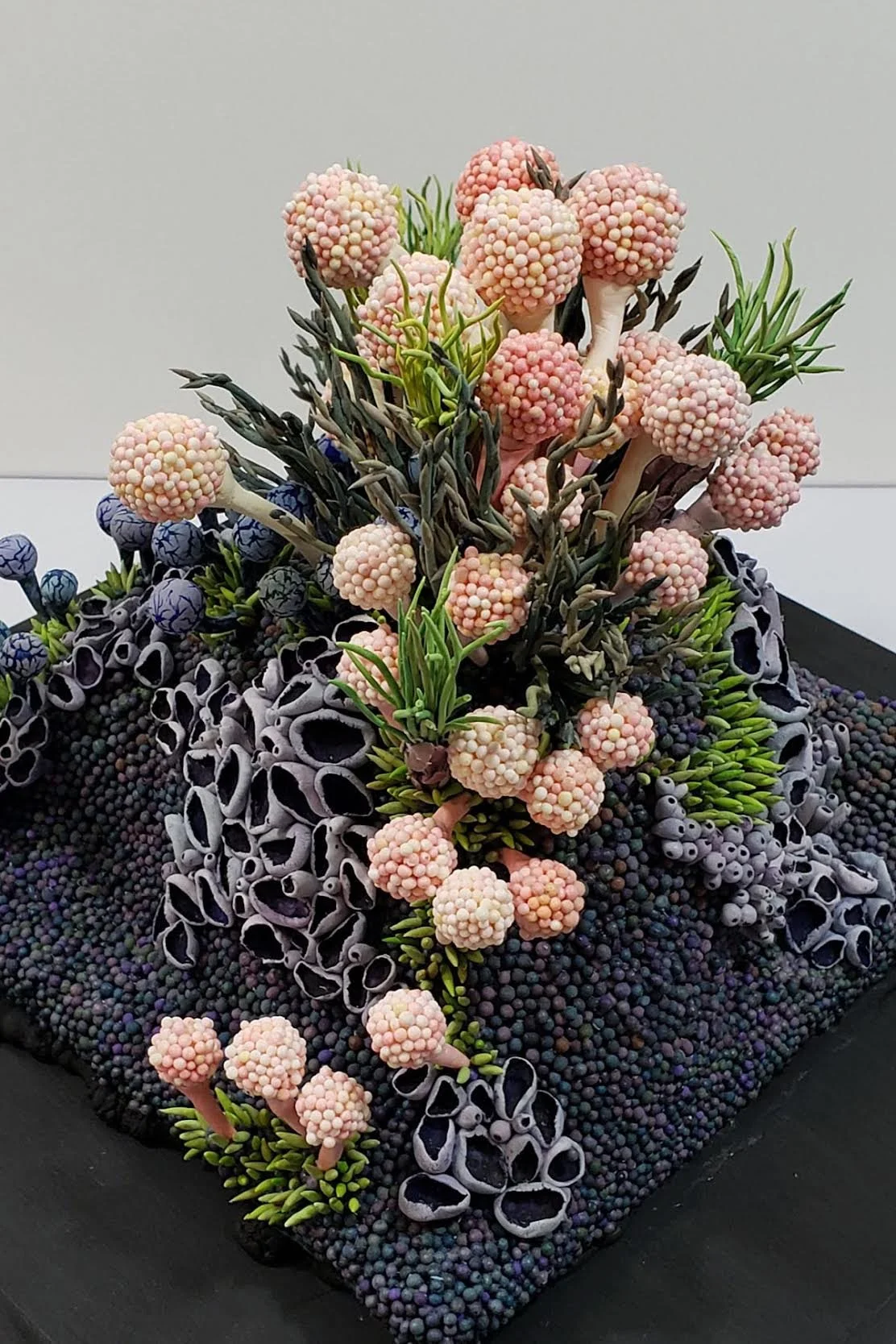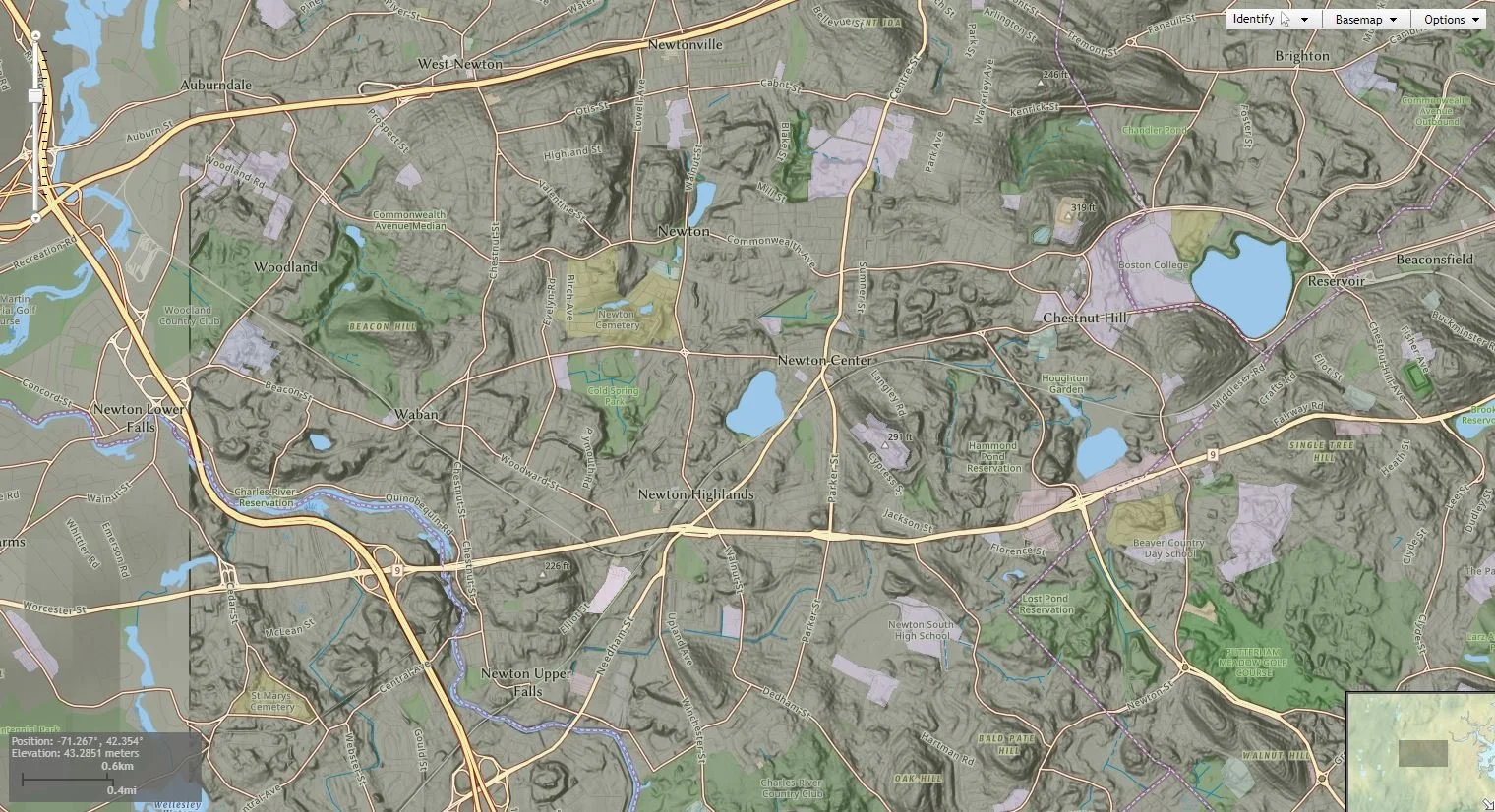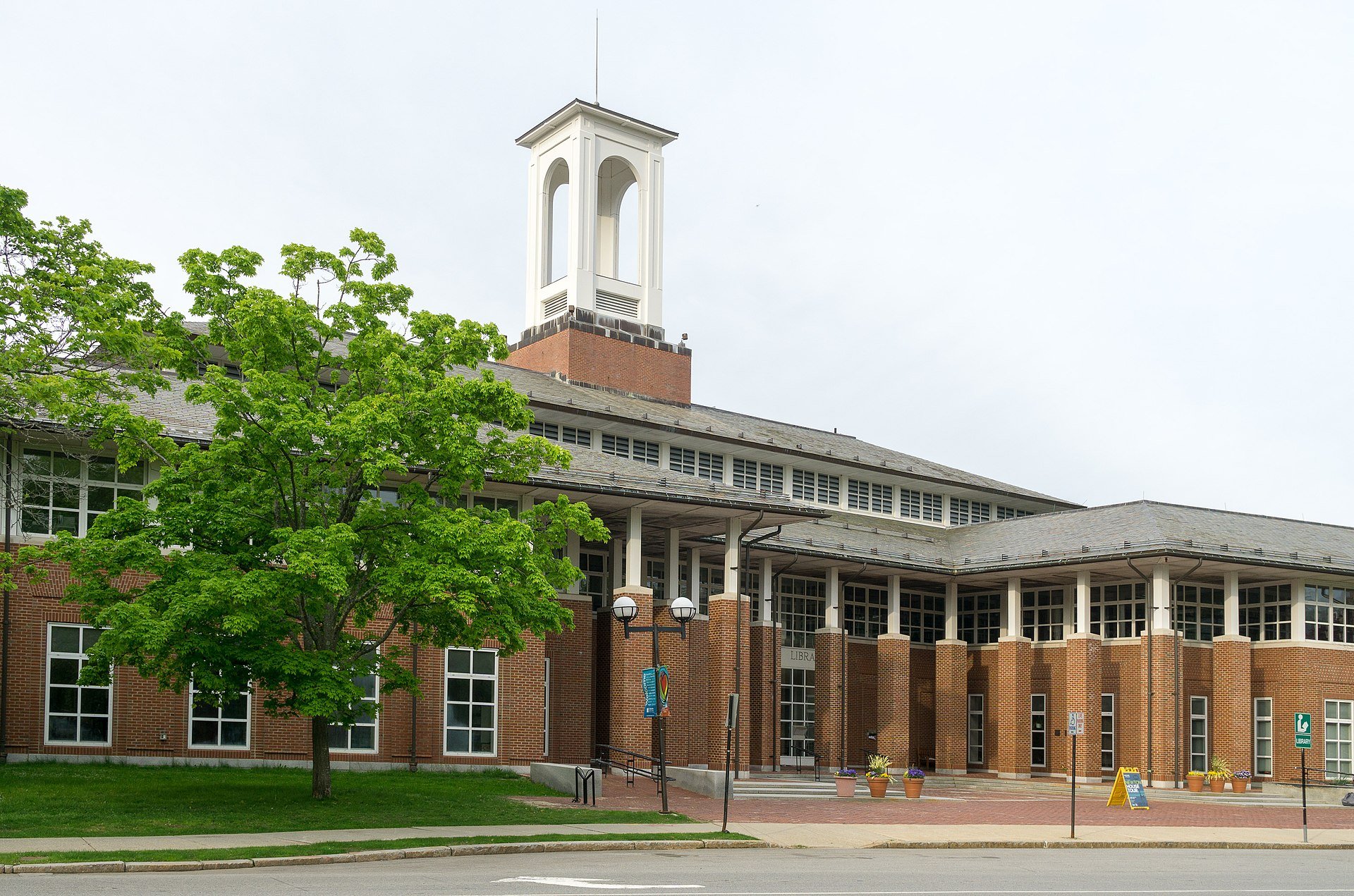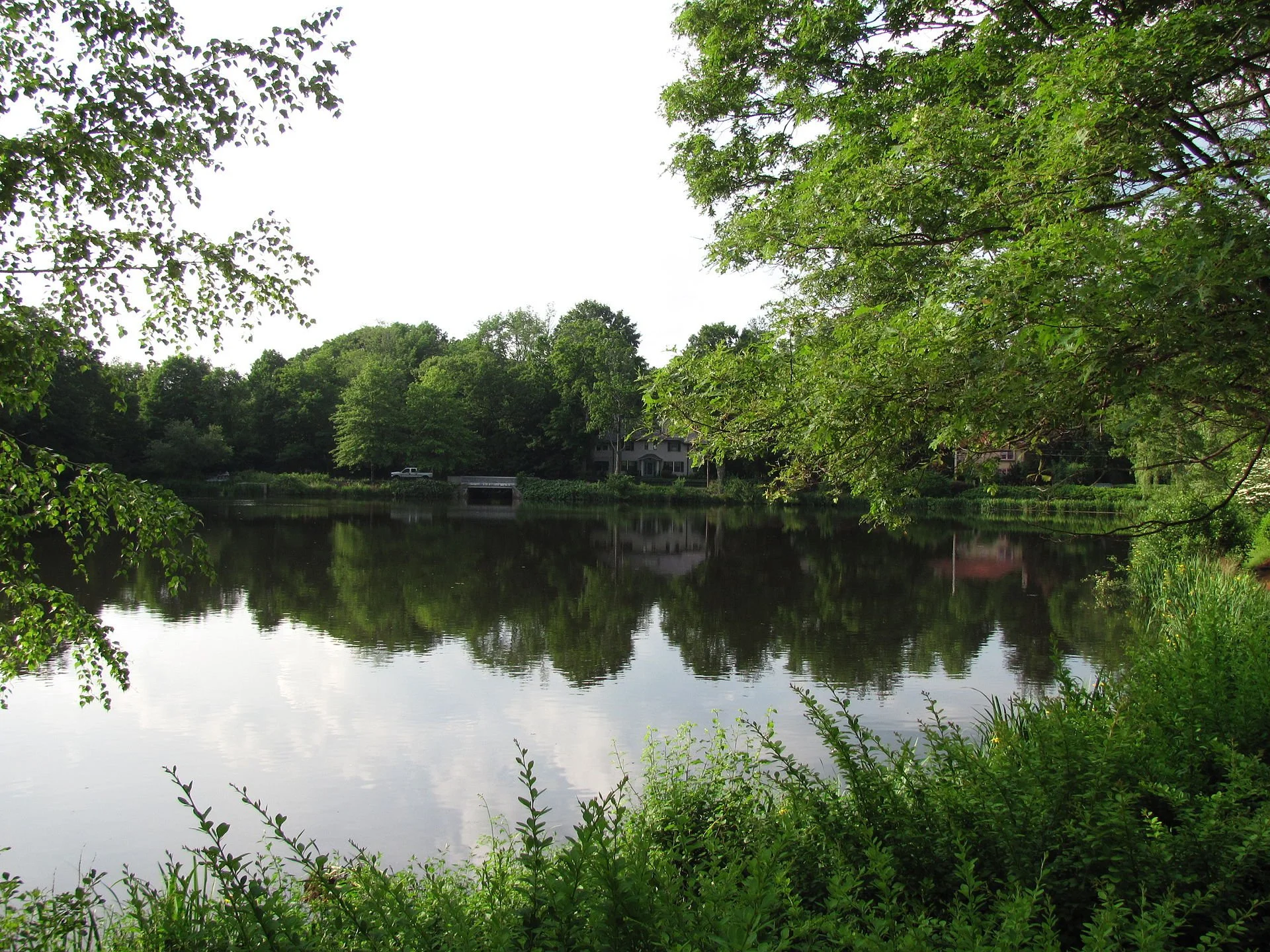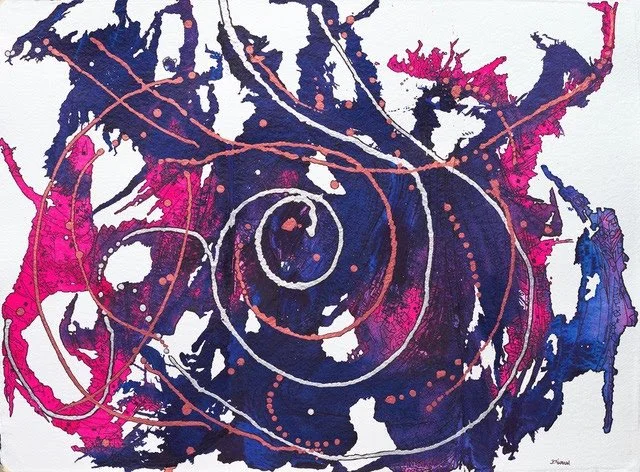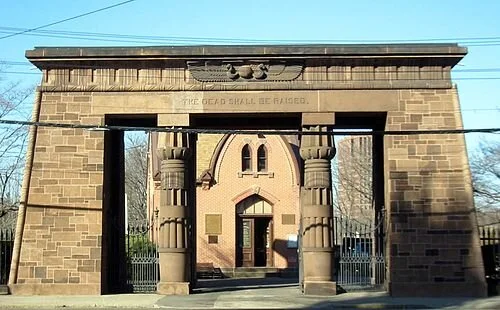
Hand language
“Rahimah Rahim,’’ by Massachusetts photographer Philip C. Keith, in the group show “Intercession ,’’at New Art Center, Newton, Mass.
Mining the ‘microworld’
From Korean-American artist Miyoung So’s show “Yet to Be Seen,’’ at Boston Sculptors Gallery, June 14-July 16
The gallery says:
“Inspired by fungal formations,’’ the show “features delicately detailed sculptural works constructed from hand-made cold porcelain and recycled materials. The artist muses, ‘As I traversed old wooden bridges, walked down roads lined with trees, and passed by my neighbors' houses, {in her hometown of Newton, Mass.} I noticed something ubiquitous: lichens, fungi, slime mold, and moss.’ She began to observe these small yet fascinating organisms closely, adjusting the zoom on her phone camera to capture their minute details. The microworld proved to be a wellspring of inspiration for her work.’’
From a National Centers for Environmental Information elevation model of Newton terrain
#So Miyoung #Boston Sculptors Gallery
Of two minds
“To Center,’’ by Newton, Mass.-based Delanie Wise, in the group show “Stirring + Layering,’’ at Boston Sculptors Gallery, Feb. 1-26.
The gallery says:
The fractured figurative work of Delanie Wise delves into our individual and collective experiences, as well as the congruity of opposing forces. Wise’s ceramic sculptures, while not definitively self-portraits, reflect her own sensibilities yet posit her life experiences are more universal than unique. A bust depicts a woman literally of two minds—her head neatly bisected, while another figure is part woman, part vase, trapped in her vessel. Or is she a magical genie emerging?’’
The Newton Public Library. The city is nationally known for its fine public schools and the generally high level of literacy, general knowledge and civic engagement of its residents.,
— Photo by Kenneth C. Zirkel
Overcoming nature
Bullough's Pond, in Newton, Mass.
— Photo by John Phelan
“Yankee wealth is the creation of human hands, not of nature. Our soil is thin, our weather cold, and the mineral resources that lie under our mountains are negligible. Yet the people who live here are and have long been prosperous….Over and over again people in this small corner of the planet have faced disaster in the forms of economic collapse or resource dearth and overcome the odds.”
— Diana Muir in her book Reflections in Bullough’s Pond, a mill pond in Newton, Mass.
We’re all stuck in it
“Gyre” (watercolor and ink), by Newton, Mass.-based painter James Varnum in the show “Beyond the Curve: Members’ Exhibition,’’ at Galatea Fine Art, Boston, Dec. 3-Jan. 16
He writes:
“My intent is for viewers to create an association, or an interpretation of the painting that triggers their own narrative.’’
“I was a creative child who liked to sit at the dining room table and draw. I took art classes at the local library during the summer in the small, rural village where I grew up, in Southern New Hampshire. After high school I studied art in Boston and San Francisco, where I earned a B.F.A. from the San Francisco Art Institute.
'‘I soon learned that I could not support myself and a new family as a fine artist, so I went into education, earned a M.Ed. and became a classroom teacher. After nine years, I wanted to specialize my work with children. I earned a M.S. in communication disorders and worked as a Speech Language Pathologist before retiring in 2011. During those thirty-plus years, I kept in touch with my creative side by taking art classes through various continuing education organizations.’’
”Upon retiring, I promised myself that I would pursue art once again. I kept that promise and am an active artist in the Boston area. I belong to several other art associations and actively exhibit my paintings. I classify myself as an experimental watercolor painter.’’
Chestnut Hill Reservoir, near Boston College, in Newton
Work site
By Alex Alderete, instructor of “Creating Fantastical Creatures,” at the New Art Center, Newton, Mass.
Those screaming invaders
Adapted from Robert Whitcomb’s “Digital Diary,’’ in GoLocal24.com
“It’s time to ban leaf blowers. The decibel level is a health hazard. Raking works.’’
Bravo to Richard Goldberg for posting this observation on the Next Door site.
See:
https://nextdoor.com/news_feed/?
For weeks every fall, and then again in the spring, affluent homeowners hire yard crews with screaming, gasoline-powered leaf blowers to make life utterly miserable for their human neighbors, as well as other animal life in the area, for hours a day. These infernal devices also emit copious quantities of air pollution. They’re a menace to health and should have been banned long ago. With so many people now forced to work at home, they’re hurting the health of many more people than ever. (Electric leaf blowers are quieter and don’t emit pollution.)
And we notice that the ears and lungs of many of the workers wielding these monsters aren’t protected. More than a few seem to be illegal aliens, who lack workplace protections. They don’t dare complain.
Hit this link to read a discussion in Newton, Mass., on the general public-health awfulness of gasoline-powered leaf blowers.
Yes, indeed, it’s time to ban gasoline-powered leaf blowers, at least in residential neighborhoods.
Deborah Danger: Estate planning for college students in the pandemic
“Death on the Pale Horse’’ (1865), by Gustave Dore
Entrance to the Grove Street Cemetery or Grove Street Burial Ground, in New Haven, Conn. It’s surrounded by the Yale University campus. The cemetery was founded in 1796 as the New Haven Burying Ground and incorporated in October 1797 to replace the crowded burial ground on the New Haven Green. Many notable Yale and New Haven luminaries are buried in the cemetery, including 14 Yale presidents.
From The New England Journal of Higher Education, a service of The New England Board of Higher Education (nebhe.org)
NEWTON, Mass.
Eleanor Roosevelt once said, “If life were predictable it would cease to be life, and be without flavor.”
Her words are excellent guideposts as New England colleges and universities navigate the unknowns of educating students during COVID-19. Despite the precautions that institutions are taking, on-campus teaching and research are not totally risk-free.
Neither, of course, is life itself.
As COVID-19 and the upcoming flu season pose new uncertainties, many faculty and administrators are brushing up against less comfortable topics, including extended illness, incapacity and death.
Over the past few weeks, up to 80 percent of the calls I have fielded were from educators and high school and college students wanting to put together estate plans, or update previous plans, as they return to the classroom. These included a 17-year-old high school student who drafted a plan and then signed it on his 18th birthday and two college freshmen who wanted these documents in place before heading to their new campuses.
My informal survey of potential clients finds that less than half have estate planning documents in place, and many who already have them in place discover that named agents have moved away or died, and previously proclaimed wishes no longer accurately reflect their current wishes. The educators and administrators who are taking action now have been spurred on by new “what if” scenarios (e.g., “If I am put on a ventilator and can’t make my wishes known, who will speak for me?” “If both my partner and I become ill, who will care for the children?”).
Estate plan elements
Estate planning is a way for individuals to ensure that: 1) their values and personal priorities will be known and honored, 2) their wishes for their family will be protected and 3) their assets will be available to provide for loved ones.
These plans include:
A will, which specifies who is to receive prized possessions and other assets when they die … including charities. It is also where they name guardians for their minor children.
A healthcare proxy, which specifies the person who can make healthcare decisions for them when they cannot. This document should be supplemented with a Health Insurance Portability and Accountability Release (HIPAA), so doctors can share their medical information with the proxy.
Revocable living trust … In most states, a will does not authorize the bypass of probate or the immediate distribution of assets upon a person’s death. The addition of a trust, in most cases, enables heirs to quickly receive what has been left to them. Naming trustees of the trust also provides protection against irresponsible spending by heirs, and premature spending by minor children.
A durable power of attorney, which grants a trusted spouse, partner, friend, relative or advisor the power to handle their finances and affairs if they become incapacitated.
Moreover, because of the nature of their work, professors should also think about:
Whether they need a literary executor (to oversee written works).
Ensuring the continuity and value preservation of “side hustles,” such as part-time teaching or tutoring gigs or running a blog or small company.
Ownership of intellectual property, such as patents, websites and creative works.
Getting personal
What about the softer and more human side of this process?
Estate planning is an opportunity to express very personal considerations about measures that should be taken to extend life, such as preferences about the use of ventilators and being artificially fed and hydrated. It’s also a way to direct a “legacy of love” and document who should give away and get possessions that have value and possessions that preserve memories. The clearer individuals are about these things, the easier it will be for their family, community and friends to honor their wishes rather than guess and argue over what they are.
For these reasons, individuals should be thoughtful and thorough, and make sure to work with a trusted advisor who can help them think through decisions about these challenging choices.
Once the conversations have been had, and estate planning documents are signed and notarized, the temptation is to close this chapter, but this is the time to share information with everyone who might require it. If one suddenly contracts a more serious case of COVID-19, it is important that every agent/decision-maker can act quickly and in synch with everyone else.
Individuals should share:
Healthcare proxies: Not only with the designated proxies, but also with each of their caregivers and specialists, their hospital of choice, employers (for Human Resource folders, so colleagues know who to call and which hospitals to request in the event of a sudden illness) and fitness centers (in the event of a heart attack, stroke or injury while working out).
Durable powers of attorney: In addition to the designated “agents,” others who would benefit from this information include banks, insurance providers, financial advisors, CPAs and college/university employers.
Will: At least one trusted person should know where the original will is kept, as this document must be filed with the court upon death (copies will not be considered valid).
Trusts: These instruments will set in motion a chain of other actions that need to be implemented in order for their full benefits to be realized; for example, all assets, including real estate, will need to be retitled in the name of the trustee.
Indeed, this is a good time to centralize all important documents in case of an emergency—from titles and deeds to birth and marriage certificates. For a checklist, click here.
COVID-19 is a wakeup call for all of us that life can instantly change. An estate plan offers a measure of control, enabling one to protect loved ones as they continue their educational work.
Deborah Danger is managing member of DangerLaw, LLC in Newton, Mass., which focuses on estate planning, post death administration, asset protection, family law, small business/entrepreneurship advising and collaborative law.
Less stressful than Disney World
Norumbega Park, in the Newton, Mass., village of Auburndale, near (not in!) Boston, opened in 1897 and closed in 1963.
Every year is extreme
Bullough's Pond, a former mill pond in now-suburban Newton, Mass.. The pond is a popular place for bird watching and ice skating. In the 19th Century, before man-made refrigeration, and when winters were colder than now, it was the site of a commercial ice business. In 18th Century New England many ponds were created by building dams on streams to create reservoirs to power small mills to grind grain.
“There are no ordinary seasons in New England, only years that are unusually rainy, or abnormally hot, or remarkably cold.’’
Historian Diana Muir, in her book Reflections in Bullough’s Pond: Economy and Ecosystem in New England
Sit there until I say you can leave
Oil and acrylic painting by Sabine Clark, with Zhanna Cantor, at New Art Center, Newton, Mass.
The way we walk now
Oil and acrylic painting by student Amelia Katzen with Zhanna Cantor at New Art Center, Newton, Mass.
Mostly innocent fun
Norumbega Park opened in June 1897. It was built at the behest of the directors of the Commonwealth Avenue Street Railway to try to increase patronage and revenues on the trolley line between Boston and the Auburndale section of Newton. The park's name was taken from the Norumbega Tower, a stone structure that Eben Norton Horsford had built in Weston to mark the purported Norse settlement called Norumbega. The amusement park was closed in 1963 and the ballroom in 1964. The park was a great place for Baby Boomer kids. I went there in 1962 when I was a student in Newton.
— Robert Whitcomb
Nimbys vs. needed new housing
Maybe not that much union these days
From Robert Whitcomb’s “Digital Diary,’’ in GoLocal24.com
Newton, Mass., has provided a strong example of why housing costs are so high: It’s tough for developers who propose projects that would increase local density in a nation where many still see the ideal as the one-family house.
While 60 percent of voters in Newton (an affluent and very liberal town) supported, in a referendum, the Northland Newton project, which will provide 800 units of housing, 140 of which will be classified as “affordable,’’ the road to the development has had a lot of potholes. Although the City Council also supported it, the developers had to go through an 18-month permitting process, and make many concessions, among other torments. Such delays drive away many developers and thus prevent the construction of new housing that could moderate housing costs by increasing supply, especially in places like Greater Boston and the San Francisco region, where these costs are astronomical.
In a Boston Globe essay, Katherine Levine Einstein and Maxwell B. Palmer, assistant professors of political science at Boston University, wrote:
“Across Massachusetts towns, from 2015 to 2017, only 14 percent of those speaking at permitting meetings about multifamily housing were in favor of the development. As the Northland referendum shows, true public support is much higher.’’ Opponents tend to be older and richer.
“Indeed, recent election results underscore an unfortunate liberal inconsistency on housing policy. On Super Tuesday, Democratic primary voters flocked to the polls to endorse candidates with robust plans to improve and increase the nation’s housing stock. The platforms of former vice president Joe Biden and Senators Bernie Sanders and Elizabeth Warren all advocate for housing policies that would make it easier to build more housing. In Newton, more than 90 percent of voters cast a vote in the Democratic primary. A sizable portion of those voters opposed those same principles when it came to their own backyards: At least 35 percent of Newton Democratic voters opposed the Northland project.’’
“Sanders’s positions illustrate this disjoint between national and local housing preferences. Sanders’s housing plan outlines regulatory and funding measures that would increase the supply of national housing for residents at a variety of income levels. Yet, he opposes local housing developments and endorses politicians in local races who fight critical zoning reform.’’
It’s a variant of the old “don’t tax me, don’t thee, tax the man behind the tree.’’
Forget rent control, which worsens housing costs by discouraging construction and expansion of multifamily owner-occupied or rental property. The way to control housing costs is to build more housing.

